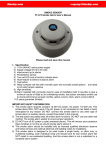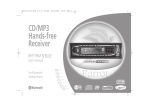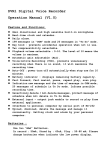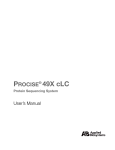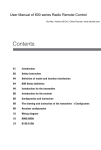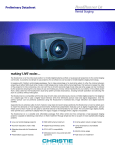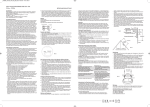Download Smoke Alarm User`s Manual
Transcript
Smoke Alarm User’s Manual Please read and save this manual VST-610A SMOKE ALARM USER’S MANUAL FEATURES Conventional Operated Photoelectric Type Smoke Alarm Photoelectric Sensor Special MCU control design Operated with 12~24VDC external loop power (powered by Control device ) High and stable sensitivity: 0.08~0.16 dB/m With wall mount plate set for easy installation LED operation indicator. Self-test button General fire alarm system compatible CE approved, UL217 Standard, BVISO9001:2000 SPECIFICATION Model Number: VST-610A Product Weight: 125g Operating Temperature:-10 to 50 ℃ ℃ Electrical Rating: 12-24VDC Standby Current: 60uA max Alarm Current: 10~30mA Detection Type: Photoelectric Chamber Humidity Rating: 10%-95% Reactive Threshold: 0.08~0.16 dB/m IMPORTANT SAFETY INFORMATION 1 . This smoke alarm requires constant 12~24VDC external loop power to operate properly. This smoke alarm WILL NOT work if DC power is not connected or has failed or been interrupted for any reason 。 2 . The push-to-test button accurately tests all smoke alarm functions. Do not use any other test method. Test smoke alarm weekly to ensure proper operation. 3 . DO NOT disconnect external loop power to quiet unwanted alarms. This will remove your protection. 4 . Red LED indicates that the smoke alarm is alarming and at the same time the Control panel will give out alarm sound after receiving signals for the smoke alarm. And when the smoke alarm is working under normal operation the LED goes out. 5 . This smoke alarm should be installed only by a licensed, qualified electrician. Observe and follow all local and national electrical and building codes for installation. 6 . This smoke alarm is designed to be used inside a single family only. In multifamily buildings, each individual living unit should have its own smoke alarms. Do not install in non-residential buildings. And this smoke alarm is not a substitute for a complete alarm system. 7 . Install a smoke alarm in every room and on every level of the home. Smoke may not reach the smoke alarm for many reasons. For example, if a fire starts in a remote part of the home, on another level, in a chimney, wall, roof, or on the other side of a closed door, smoke may not reach the smoke alarm in time to alert household members. A smoke alarm will not promptly detect a fire except in the area or room in which it is installed. 8 . Smoke alarms may not alert every household member every time. The Control panel alarm horn of smoke alarms is loud in order to alert individuals to a potential danger. However, there may be limiting circumstances where a household member may not hear the alarm (i.e. outdoor or indoor noise, sound sleepers, drug or alcohol usage, the hard of hearing, etc.). If you suspect that this smoke alarm may not alert a household member, install and maintain specialty smoke alarms. Household member must hear the alarm’s warning sound and quickly respond to it to reduce the risk of damage, injury, or death that may result from fire. If a household member is hearing impaired, install special smoke alarms with lights or vibrating devices to alert occupants. 9 . Smoke alarms can only give alarm signals when they detect smoke. Smoke alarms detect combustion particles in the air. They do not sense heat, flame, or gas. However, many fires are fast-burning, explosive, or intentional. Others are caused by carelessness or safety hazards. Smoke may not reach the smoke alarm QUICKLY ENOUGH to ensure safe escape. 10. Smoke alarms have limitations. This smoke alarm is not foolproof and is not warranted to protect lives or property from fire. Smoke alarms are not a substitute for insurance. Homeowners and renters should insure their lives and property. In addition, it is possible for the smoke alarm to fail at any time. For this reason, you must test the smoke alarm weekly and replace every 5 years. Note: For best protection, we recommend that you install a smoke alarm in every room. SMOKE ALARM PLACEMENT BEDROOM Typical single-story home KITCHEN DINING ROOM Install a smoke alarm on the ceiling of wall inside each bedroom and in the hallway outside each separate sleeping area. If a bedroom area hallway is more than 30 feet long, install a LIVING ROOM smoke alarm at each end. If there is a basement: Install a BEDROOM smoke alarm on the basement ceiling at the bottom of the SINGLE-STORY RESIDENCE,APARTMENT, stairwell. MOBILE HOME Typical Multi-story or split level home Install a smoke alarm on the ceiling of wall inside each bedroom and in the hallway outside each separate sleeping area. If a bedroom area hallway is more than 30 feet long, install a smoke alarm at each end. And please install a smoke alarm on the top of a first-to-second floor stairwell. BEDROOM LIVING ROOM HALL BEDROOM KITCHEN KEY: ●Minimum required smoke alarm locations FINISHED BASEMENT ○Recommended additional smoke alarm locations △Smoke alarms with silence features recommended MULTI-STORY RESIDENCE for additional protection IMPORTANT SMOKE ALARM PLACEMENT AND EXCEPTION INFORMATION 1 Install a smoke alarm as close to the center of the ceiling as possible. If this is not practical, mount no closer than 4 inches from a wall or corner. Also, if local codes allow, install smoke alarms on walls, between 4 and 12 inches from ceiling/wall intersections. 2 Install a minimum of two smoke alarms in every home, no matter how small the home. 3 Install a smoke alarm in each room that is divided by a partial wall (either coming down from the ceiling at least 8 inches, or coming up from the floor). 4 Install a smoke alarm in lived-in attics which house electrical equipment like furnaces, air conditioners, or heaters. DO NOT INSTALL SMOKE ALARMS 10CM(4'') CEILING ACCEPTABLE HERE 0.9M(3ft) 10CM(4'') NEVER HERE MAXIMUM BEST HERE 10CM(4'') ANYWHERE IN THIS AREA MINIMUM MINIMUM 0.9M(3ft) HORIZONTAL DISTANCE FROM PEAK SIDEWALL 1 Near appliances or areas where normal combustion regularly occurs (kitchens, near furnaces, hot water heaters). Use specialized smoke alarm with unwanted alarm control for this areas. 2 In areas with high humidity, like bathrooms or areas near dishwashers or washing machines. Install at least 10 feet away from these areas. 3 Near air returns or heating and cooling supply vents. Install at least 3 feet away from these areas. The air could blow smoke away from the detector, interrupting its alarm. 4 In rooms where temperatures may fall below 40 or rise above 100 . 5 In extremely dusty, dirty, or insect-infested areas where loose particles interfere with smoke alarm operation. ℉ ℉ HOW TO INSTALL THIS SMOKE ALARM WARNING: This smoke alarm should be installed only by a qualified electrician. Smoke alarm installation must be in accordance with the requirements of Article 760 of the national electrical code and any local codes that may apply. DANGER: ELECTRICAL SHOCK HAZARD. Turn off power at the main fuse box or circuit breaker by removing the fuse or switching the circuit breaker to the off position. 1. From back of smoke alarm, turn mounting plate counterclockwise to remove mounting plate. 2. Secure plate to ceiling or wall with mounting screws. 3. Connect 12~24VDC external loop power (powered by Control device). 4. Position smoke alarm to mounting plate and turn clockwise to lock into place. 5. Push test button to test smoke alarm. See testing the smoke alarm. TESTING THE SMOKE ALARM 1. Test each smoke alarm to be sure it is installed correctly and operating property. 2. The push-to-test button accurately tests functions. Do not use an open flame to test this smoke alarm. You may ignite and damage the smoke alarm or your home. 3. Test smoke alarms weekly and upon returning from vacation or when no one has been in the household for several days. DANGER: If the red LED lights and the Control device of smoke alarm gives off alarm warning, and the smoke alarm is not being tested, the smoke alarm is sensing smoke. THIS KIND OF SITUATION REQUIRES YOUR IMMEDDIATE ATTENTION AND ACTION. MAINTENANCE AND CLEANING In addition to weekly testing, this smoke alarm requires yearly battery replacement and periodic cleaning to remove dust, dirt, and debris. BATTETY REPLACEMENT CLEANING Clean the smoke alarm at least once a month to remove dust, dirt, or debris. Using the soft brush or wand attachment to a vacuum cleaner, vacuum all sides and cover of smoke alarm. Be sure all the vents are free of debris. If necessary, use a damp cloth to clean smoke alarm cover. IMPORTANT: Do not attempt to remove the cover of clean inside the smoke alarm. This will avoid warranty. PRACTICE FIRE SAFETY If the Control panel of the smoke alarm sounds its alarm horn, and you have not pushed the test button, it is warning of a dangerous situation. Your immediate response is necessary. To prepare for such occurrences, develop family escape plans, discuss them with all household members, and practice them regularly. 1 Expose everyone to the sound of the Control panel of a smoke alarm and explain what the sound means. 2 Determine two exits from each room and an escape route to the outside from each exit. 3 Teach all household members to touch the door and use an alternate exit if the door is hot. Instruct them not to open the door if the door is hot. 4 Teach household members to crawl along the floor to stay below dangerous smoke, fumes and gases. 5 Determine a safe meeting place for all members outside the building. WHAT TO DO IN CASE OF FIRE 1 Do not be panic; stay calm. 2 Leave the building as quickly as possible. Touch doors to feel if they are hot before opening them. Use an alternate exit if necessary. Crawl along the floor, and do not stop to collect anything. 3 Meet at a pre-arranged meeting place outside the building. 4 Call the fire department from outside the building. 5 Do not go back inside a burning building. Wait for the fire department to arrive. These guidelines will assist you in the event of a fire. However, to reduce the chance that fires will start, practice fire safety rules and prevent hazardous situations.





